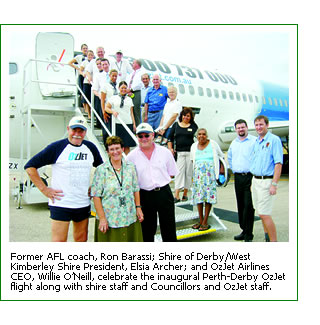At the 2006 National General Assembly in Canberra, we invited delegates to share their Council’s projects and initiatives to win a full page feature in FOCUS. This month we feature the Shire of Derby/West Kimberley, Western Australia.
The future is looking bright for the Shire of Derby/West Kimberley – ‘the true Kimberley’ – as it joins many of Western Australia’s north west towns being swept up in the economic boom. The Shire covers a vast area of 102,700 square kilometres and is located more than 2,000 kilometres north of Perth. It has a population of approximately 7,400 people and is made up of numerous Aboriginal communities and two main towns – Derby and Fitzroy Crossing. The Shire has some of the most unique natural attractions the Kimberley has to offer.
A number of projects are either confirmed or in the pipeline for 2007, which will bring substantial financial and social growth to the Shire. The most exciting project is the prospect of the Shire’s regional centre, Derby, becoming home to a multi million dollar marine industry park. If it proceeds, the park will bring millions of dollars in industry to the town and have the potential to spur its biggest population and infrastructure growth in many years.
Combined with the reintroduction of direct flights from Derby to Perth last month, and the release later this year of Derby’s first major private residential subdivision, the Shire of Derby/West Kimberley is poised for an exciting year.
Big economic plans for Derby
The Shire of Derby/West Kimberley is progressing in its bid to be home to a new marine and industrial facility that will attract hundreds of millions of dollars in industry and infrastructure to the region. The Shire awarded a contract to consultants, Gutteridge Haskins Davey (GHD), to conduct a pre feasibility study into locating the facility at Point Torment in the West Kimberley.
Shire Chief Executive Officer, John Pearson, said the primary focus of this study is to determine the best location for a supply base to support the Browse Basin projects currently being investigated by companies such as Woodside and Inpex, as well existing iron ore projects in the hinterland.
“GHD will be conducting a survey of all interested parties to ensure that any proposed location or facility design best meets the needs of the industry and other users of the proposed facility,” he said.
A working party was formed by the Shire of Derby/West Kimberley in mid 2006 to develop the idea of an industrial supply base. It has met on several occasions. The terms of reference for the working party include identifying the most appropriate location and fully exploring the costs associated with any development.
“Ultimately, any sites for such a facility will need to address the requirements of industry including the mining sector, business and government,” John Pearson said. “Obviously, we think there is a strong case for Point Torment and would be pleased to see it come to fruition.
“If we are successful in securing the marine and industrial facility, it will have significant spin offs for the region, attracting multi million dollar industries and the associated infrastructure and population.”
The outcome of the pre feasibility study is expected in April.
Private developers move in
Industry and government agencies are not the only ones recognising Derby’s bright future. Private developers are also acknowledging the potential growth of the town and have approached the Shire of Derby/West Kimberley to develop what will be Derby’s first major private residential subdivision. The subdivision’s Development Guide Plan was approved by Council following public consultation and is now being considered by the Western Australian Planning Commission. Named Ashley Grove Estate, it comprises 27 blocks ranging in size from 600 square metres to 700 square metres, plus three grouped and/or multiple dwelling sites.
The subdivision could yield up to 75 dwellings depending on the dwelling types constructed. The blocks are expected to be released by the end of the year and will be complemented by a second residential subdivision being planned in Derby by Landcorp, the State Government’s land and property developing agency.
Derby flies high with OzJet
The first direct flight from Perth to Derby in 15 years took to the skies last month, following three years of negotiations by the Shire of Derby/West Kimberley. Operated by OzJet, the service runs three times a week to and from Derby, catering for mining employees, private and business travellers. As demand grows, so too will the number of flights.
The service is expected to boost tourism in the region and has already won over local residents who no longer have to travel 232 kilometres to Broome airport. It has also given the disused civil terminal at the RAAF Curtin Airbase, located 35 kilometres from Derby, a new lease of life. More than $200,000 was spent on upgrades to accommodate the OzJet flights.
Shire President, Councillor Elsia Archer, said it has been the vision of Council to see the service recommence since the last Ansett flight in 1992. She said the Shire held an air services summit three years ago to investigate the possibility of getting the jet service started in Derby again. Since then, relevant parties, including the Shire, OzJet and local mining companies, have worked together to ensure a sustainable volume of passengers to justify the service.
“I would like to thank all the people involved in negotiations, particularly the executive staff employed by our Council, the Department of Planning and Infrastructure, OzJet Chief Executive Officer, Willie O’Neill, and John Theodorsen of Theodorsen Consulting,” Councillor Archer said. “Without these people the service would never have recommenced.”
The inaugural flight to Derby on 27 February attracted media attention from across Australia and was commemorated with a visit by special guest, Ron Barassi. The former AFL coach and sporting legend, whose 71st birthday coincided with the event, spent his time meeting local residents and business owners in Derby. He also held a football clinic for juniors before boarding the two and a half hour flight back to Perth.
Councillor Archer said the long awaited return of direct flights to Perth has brought with it a welcome spotlight on the Shire of Derby/West Kimberley, which is set to benefit hugely from the venture. She said the Shire’s long term vision was to expand Derby Airport to accommodate the OzJet flights and bring the service closer to town.
“We are urging everyone to support the service,” she said. “We worked hard to reach this goal and keeping the service in operation is the next challenge.”
OzJet operates the 106 seat, 737-200 service from Perth airport on Tuesday, Wednesday and Thursday, departing at 5.30am and arriving at Curtin at 8.10am. Flights depart Derby at 11.10am and arrive in Perth at 2.00pm.
Rich history to be preserved
The Shire of Derby/West Kimberley is playing a key role in identifying, preserving and protecting the region’s archival heritage. It instigated the formation of the Kimberley Archive Management Project Committee, comprising of community representatives and representatives from organisations that have a regional role.
The Shire provides administrative assistance and funding for the committee, which was also funded by the Kimberley Development Commission, Department of Indigenous Affairs and the three other Kimberley Shires. There is currently no established archive facility in the Kimberley region, a situation that has created several problems for government departments, community members, researchers and other agencies, and put significant historical documents, records, photographs and other archival material at risk.
The committee has worked closely with a consultant and the community to develop a Kimberley Archive Project Concept Plan, which outlines how a Kimberley Archive will be established. This will ensure the wealth of the Kimberley’s archival material can be protected and accessed into the future.
The plan has received Kimberley wide support and will progress to the implementation stage once additional funding has been secured.








